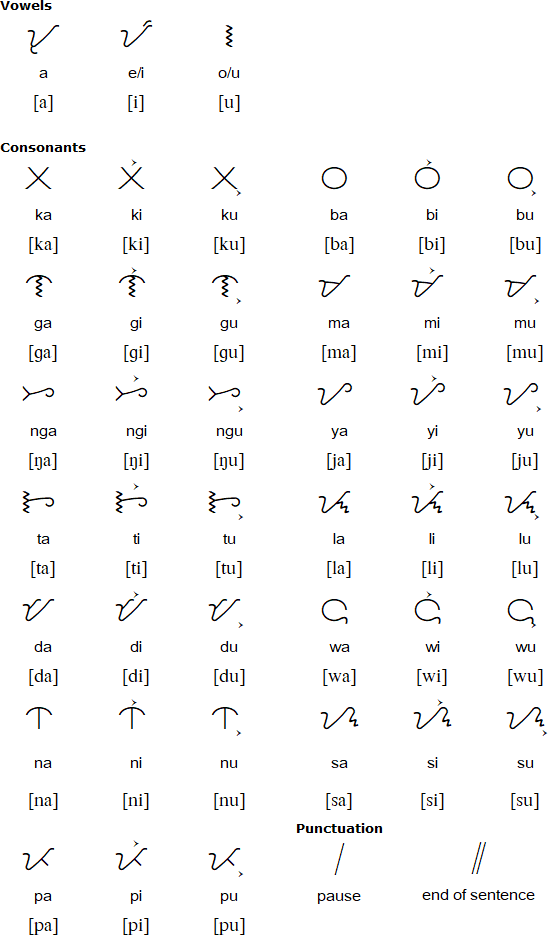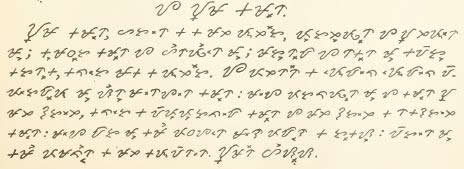Tagbanwa script (original) (raw)
The Tagbanwa alphabet was used until the 17th century, and is closely related to Baybayin. It is thought to have descended from the Kawi script of Java, Bali and Sumatra, which in turn descended from the Pallava script, one of the southern Indian scripts derived from Brahmi.
Notable features
- Type of writing system: Abugida / Syllabic Alphabet in which each consonant has an inherent vowel /a/. Other vowels are indicated either by separate letters, or by diacritics. When vowels appear at the beginning of words or one they own, they are represented by separate letters.
- Writing direction: traditionally written on bamboo in vertical columns from bottom to top and left to right, and read from left to right in horizontal lines.
- Used to write: Tagbanwa languages: Aborlan Tagbanwa, Calamian Tagbanwa and Central Tagbanwa
Aborlan Tagbanwa, Calamian Tagbanwa and Central Tagbanwa are spoken in the north of Palawan province in the Philippines. They belong to the Philippine branch of the Malayo-Polynesian language family.
Tagbanwa alphabet

Download an alphabet chart for Tagbanwa (Excel)
Sample text in Tagbanwa (Lord's prayer)

Source: http://archive.org/details/tagbanwaalphabet00romurich
Sample text supplied by Wolfgang Kuhl
Information about the Tagbanwa Script | Aborlan Tagbanwa | Calmian Tagbanwa | Central Tagbanwa | Numbers | Tower of Babel
Links
Information about the Tagbanwa script
https://en.wikipedia.org/wiki/Tagbanwa_script
https://baybayink.files.wordpress.com/2007/09/tagbanwa-alphabet-bw.pdf
Tagbanwa fonts
https://www.google.com/get/noto/#sans-tagb
https://nordenx.blogspot.com/p/downloads.html
Abugidas / Syllabic alphabets
Ahom,Aima,Arleng,Badagu,Badlit,Basahan,Balinese,Balti-A,Balti-B,Batak,Baybayin,Bengali,Bhaiksuki,Bhujimol,Bilang-bilang,Bima,Blackfoot,Brahmi,Buhid,Burmese,Carrier,Chakma,Cham,Cree,Dehong Dai,Devanagari,Dham Lipi,Dhankari / Sirmauri,Ditema,Dives Akuru,Dogra,Ethiopic,Evēla Akuru,Fox,Fraser,Gond,Goykanadi,Grantha,Gujarati,Gunjala Gondi,Gupta,Gurmukhi,Halbi Lipi,Hanifi,Hanuno'o,Hočąk,Ibalnan,Incung,Inuktitut,Jaunsari Takri,Javanese,Kaithi,Kadamba,Kamarupi,Kannada,Kawi,Kharosthi,Khema,Khe Prih,Khmer,Khojki,Khudabadi,Kirat Rai,Kōchi,Komering,Kulitan,Kurukh Banna,Lampung,Lanna,Lao,Lepcha,Limbu,Lontara/Makasar,Lota Ende,Magar Akkha,Mahajani,Malayalam,Meitei (Modern),Manpuri (Old),Marchen,Meetei Yelhou Mayek,Meroïtic,Masarm Gondi,Modi,Mon,Mongolian Horizontal Square Script,Multani,Nandinagari,Newa,New Tai Lue,Ojibwe,Odia,Ogan,Pahawh Hmong,Pallava,Phags-pa,Purva Licchavi,Qiang / Rma,Ranjana,Rejang (Kaganga),Sasak,Savara,Satera Jontal,Shan,Sharda,Sheek Bakrii Saphaloo,Siddham,Sinhala,Sorang Sompeng,Sourashtra,Soyombo,Sukhothai,Sundanese,Syloti Nagri,Tagbanwa,Takri,Tamil,Tanchangya (Ka-Pat),Tani,Thaana,Telugu,Thai,Tibetan,Tigalari,Tikamuli,Tocharian,Tolong Siki,Vatteluttu,Warang Citi
Page last modified: 16.03.23
[top]
You can support this site by Buying Me A Coffee, and if you like what you see on this page, you can use the buttons below to share it with people you know.
If you like this site and find it useful, you can support it by making a donation via PayPal or Patreon, or by contributing in other ways. Omniglot is how I make my living.
Note: all links on this site to Amazon.com


[top]


